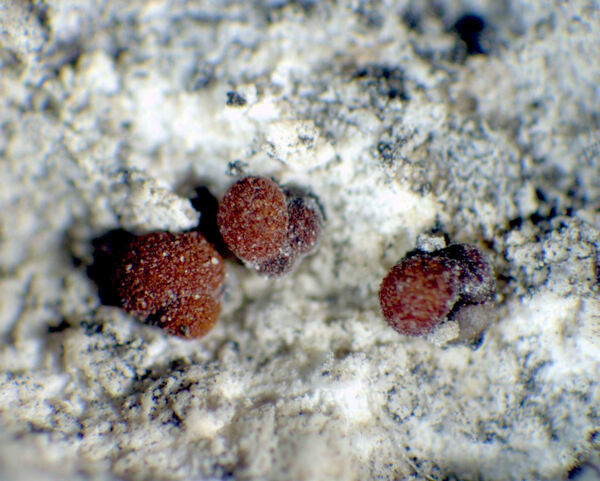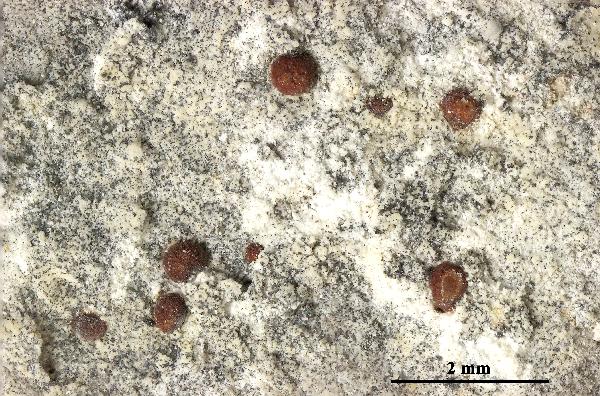Protoblastenia cyclospora (Körb.) Poelt
Mitt. bot. Staatss. München, 12: 5, 1975. Basionym: Biatora cyclospora Hepp ex Körb. - Parerga Lichenol.: 152, 1860.
Synonyms: Biatora rubidula (Nyl.) Walt. Watson; Lecidea cyclospora (Körb.) Müll. Arg.; Lecidea rubidula Nyl.; Protoblastenia globulificans (Nyl.) Zahlbr.
Distribution: N - Frl (Henssen & Tretiach 1995, Vezda Lich. Rar. Exs. 326, Kainz & Rambold 2004, Peršoh & al. 2004), TAA (TSB 20345). C - Tosc (Benesperi 2006, 2007, 2007b), Abr (Nimis & Tretiach 1999, Gheza & al. 2021), Mol (Nimis & Tretiach 1999, Caporale & al. 2008), Sar (Tretiach 2015q). S - Camp (Aprile & al. 2003b).
Description: Thallus crustose, endosubstratic or more rarely thinly episubstratic, continuous or rarely finely cracked, pale grey to grey-white, most often inconspicuous. Apothecia biatorine,(0.35-)0.45-0.8 mm across, sessile, slightly to strongly constricted at base, not immersed in pits, with a strongly convex, dark orange-red disc and an indistinct proper margin. Proper exciple poorly developed, of colourless, branched hyphae; epithecium orange-red, 15-25 µm high, with granular crystals reacting K+ red, N-; hymenium colourless or more often with reddish stripes in upper part, 80-100 µm high; paraphyses coherent, sparingly branched and anastomosing, 2-3.5 µm thick at mid-level, the apical cells slightly swollen, 3-4 µm wide; hypothecium yellow-orange to pale orange-red, patchily pigmented. Asci 8-spored, clavate, with a well-developed, amyloid tholus containing a more intensely amyloid, indistinct tube structure, without an ocular chamber, approximating the Porpidia- or Psora-types. Ascospores 1-celled, hyaline, globose or subglobose, (5-)7-9 x 5-7.5 µm, without a distinct perispore. Photobiont chlorococcoid. Spot tests: thallus K-, C-, KC-, P-; apothecia K+ purple-red. Chemistry: apothecia with anthraquinones, mainly parietin.Note: on steeply inclined surfaces of calcareous rocks in humid-rainy areas below the Alpine belt; to be looked for in other parts of Italy with very high precipitation and calcareous-dolomitic substrata (e.g. the Apuan Alps).
Growth form: Crustose
Substrata: rocks
Photobiont: green algae other than Trentepohlia
Reproductive strategy: mainly sexual
Most common in areas with a humid-warm climate (e.g. most of Tyrrenian Italy)
Commonnes-rarity: (info)
Alpine belt: absent
Subalpine belt: extremely rare
Oromediterranean belt: absent
Montane belt: rare
Submediterranean belt: very rare
Padanian area: absent
Humid submediterranean belt: extremely rare
Humid mediterranean belt: absent
Dry mediterranean belt: absent

Predictive model
Herbarium samples
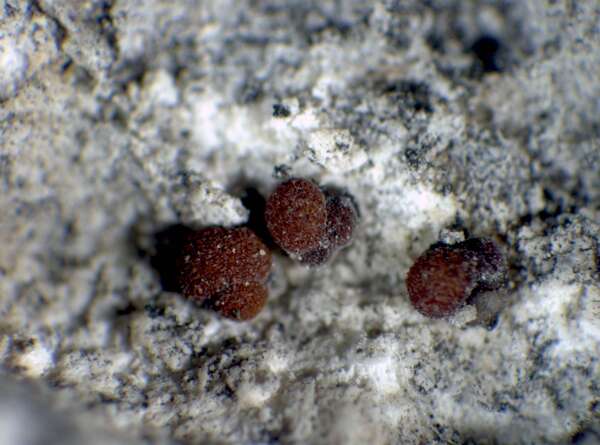

P.L. Nimis; Owner: Department of Life Sciences, University of Trieste
Herbarium: TSB (29271)
2001/11/29
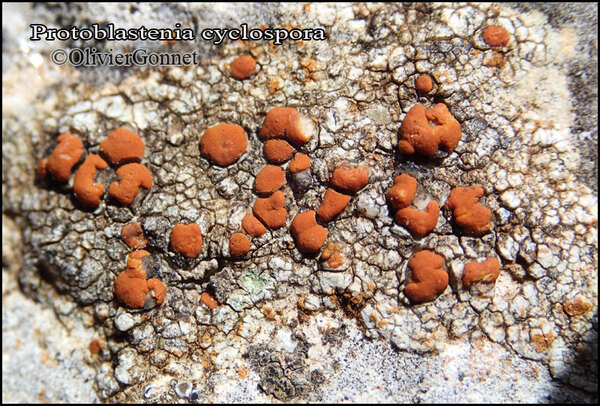
Courtesy Danièle et Olivier Gonnet - Source: https://www.afl-lichenologie.fr/Photos_AFL/Photos_AFL_P/Text_P_3/Protoblastenia_cyclospora.htm
France, 3/8/2013 - Lanslebourg, Mont-Cenis - alt. 2000 m - Savoie
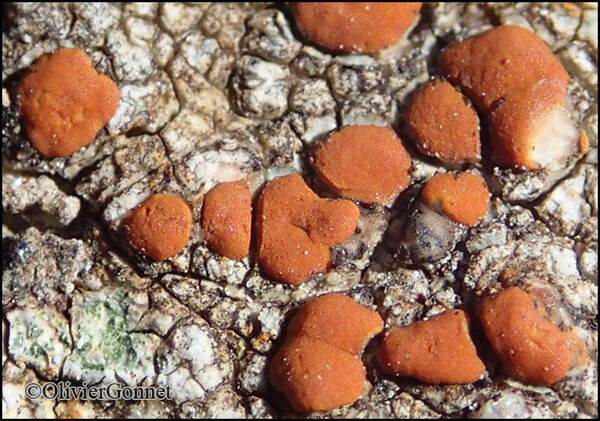
Courtesy Danièle et Olivier Gonnet - Source: https://www.afl-lichenologie.fr/Photos_AFL/Photos_AFL_P/Text_P_3/Protoblastenia_cyclospora.htm
France, 3/8/2013 - Lanslebourg, Mont-Cenis - alt. 2000 m - Savoie
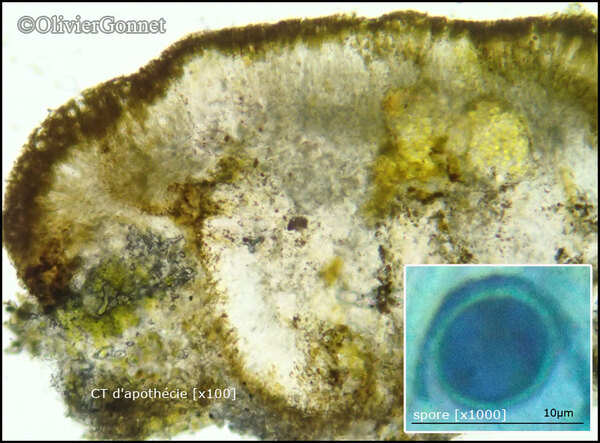
Courtesy Danièle et Olivier Gonnet - Source: https://www.afl-lichenologie.fr/Photos_AFL/Photos_AFL_P/Text_P_3/Protoblastenia_cyclospora.htm
France, 3/8/2013 - Lanslebourg, Mont-Cenis - alt. 2000 m - Savoie
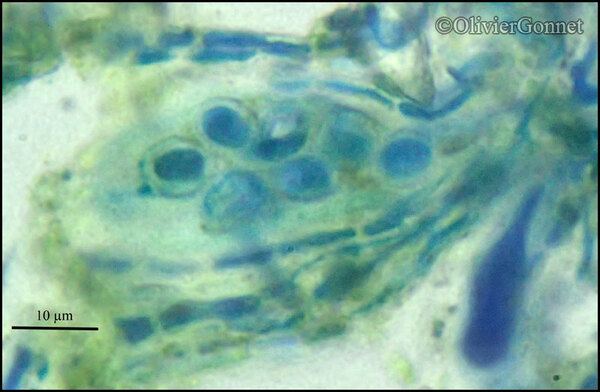
Courtesy Danièle et Olivier Gonnet - Source: https://www.afl-lichenologie.fr/Photos_AFL/Photos_AFL_P/Text_P_3/Protoblastenia_cyclospora.htm
France, 3/8/2013 - Lanslebourg, Mont-Cenis - alt. 2000 m - Savoie
Growth form: Crustose
Substrata: rocks
Photobiont: green algae other than Trentepohlia
Reproductive strategy: mainly sexual
Most common in areas with a humid-warm climate (e.g. most of Tyrrenian Italy)
Commonnes-rarity: (info)
Alpine belt: absent
Subalpine belt: extremely rare
Oromediterranean belt: absent
Montane belt: rare
Submediterranean belt: very rare
Padanian area: absent
Humid submediterranean belt: extremely rare
Humid mediterranean belt: absent
Dry mediterranean belt: absent

Predictive model
| Herbarium samples |


P.L. Nimis; Owner: Department of Life Sciences, University of Trieste
Herbarium: TSB (29271)
2001/11/29

Courtesy Danièle et Olivier Gonnet - Source: https://www.afl-lichenologie.fr/Photos_AFL/Photos_AFL_P/Text_P_3/Protoblastenia_cyclospora.htm
France, 3/8/2013 - Lanslebourg, Mont-Cenis - alt. 2000 m - Savoie

Courtesy Danièle et Olivier Gonnet - Source: https://www.afl-lichenologie.fr/Photos_AFL/Photos_AFL_P/Text_P_3/Protoblastenia_cyclospora.htm
France, 3/8/2013 - Lanslebourg, Mont-Cenis - alt. 2000 m - Savoie

Courtesy Danièle et Olivier Gonnet - Source: https://www.afl-lichenologie.fr/Photos_AFL/Photos_AFL_P/Text_P_3/Protoblastenia_cyclospora.htm
France, 3/8/2013 - Lanslebourg, Mont-Cenis - alt. 2000 m - Savoie

 INDEX FUNGORUM
INDEX FUNGORUM
 GBIF
GBIF
 DOLICHENS
DOLICHENS
